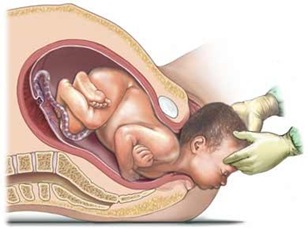With the exception of very few women, most hope to experience natural childbirth and delivery. It is indeed an intense experience and it would do you immense good to educate yourself and approach child birth and delivery with an open mind.
The baby is delivered during the second stage of labour when the cervix is completely dilated to ten cm. You will be required to focus and concentrate to cope with contractions and gradually push your baby through the birth canal. You will feel an intense urge to bear and push down, and also a lot of pressure on the rectum.
 You can deliver the baby while sitting, reclining or squatting; it’s up to you to decide what position works best for you. Some may prefer to have their husbands with them during childbirth. Once it is time for you to start pushing, your baby should be well positioned in the birth canal. This can be a frustrating aspect of child birth since, with each push, the baby slips back a little. As your baby nears the vaginal opening, you start experiencing extreme pressure on the perineum that is the skin between the rectum and vagina. Gently massaging and stretching the perineum avoids tearing or the doctor may opt to perform episiotomy, which is a small cut made to accommodate the baby’s head down through the vagina.
You can deliver the baby while sitting, reclining or squatting; it’s up to you to decide what position works best for you. Some may prefer to have their husbands with them during childbirth. Once it is time for you to start pushing, your baby should be well positioned in the birth canal. This can be a frustrating aspect of child birth since, with each push, the baby slips back a little. As your baby nears the vaginal opening, you start experiencing extreme pressure on the perineum that is the skin between the rectum and vagina. Gently massaging and stretching the perineum avoids tearing or the doctor may opt to perform episiotomy, which is a small cut made to accommodate the baby’s head down through the vagina.
As the baby crowns, you will experience a burning and stretching sensation. As the baby fully crowns, you will start feeling immense relief from the massive intense pain. Once your baby’s head comes out, the body will rotate and each shoulder comes through one at a time. The medical team present at the time of delivery suctions out the baby’s nose and mouth to clear it of any fluid and the doctor skillfully guides the rest of the baby out.
A normal vaginal delivery can take anywhere from a few minutes to several hours depending solely on the number of previous deliveries the mother has had ,the size of the baby and other factors. At times, babies need a little help during child birth. Doctors may use forceps or vacuum to gently push the baby out.
Some women spend hours in labour pushing unsuccessfully and this may have to end in caesarean section. In some instances, a vaginal delivery may not be possible due to incorrect positioning of the baby. A large baby may not be able push down through the pelvis and the mother may find herself in danger or acute distress. Here too a caesarean is performed.